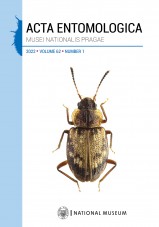Revision of Quedius sensu stricto (Coleoptera: Staphylinidae)
Hansen Aslak K., Brunke Adam, Simonsen Thomas, Solodovnikov Alexey
Acta Entomologica Musei Nationalis Pragae 62(1): 225-299, 2022
Published online: 26th November 2022
Views: 2248
Abstract: We here present the first integrative revision of the subgenus Quedius Stephens,
1829 sensu stricto where taxonomic decisions are based on morphology, genomic
phylogeny (published elsewhere) and single locus DNA evidence. The subgenus is
restricted to the Holarctic region and includes some of the largest, most robust
members of the genus Quedius. For species delimitation, a total of 200 COI
barcodes covering nearly all species within the subgenus were evaluated through
phylogenetic, cluster and network analysis. Taxonomic, distributional and
bionomic data, all hitherto published and new are synthesized and an
identification key is constructed for all species. All 20 species of Quedius s.
str. are divided into five species groups based on genomic phylogeny,
morphology, distributional patterns and practical considerations. Overall, there
was good congruence among various lines of evidence. As exceptions, high COI
barcode variability was found within the wingless and patchily distributed Q.
unicolor Kiesenwetter, 1847 and Q. sundukovi Smetana, 2003 (3 and 5 BOLD
BINs, respectively) from the Q. molochinus-group without corresponding
morphological or geographic patterns. On the contrary, in the Q. pallipes-group
very little divergence in the COI barcode was found between clearly
morphologically separated species. From the taxonomically challenging Nearctic
Quedius molochinoides-group, Quedius altanai Hansen & Brunke sp. nov. is
described as new species from the central and southern Rockies, rendering Q.
lanei Hatch, 1957 to be restricted to the eastern foothills of the Cascades,
Sierra Nevada and Blue Mountains. In the case of Q. subunicolor and Q. altaicus,
continuous morphological and COI variation firmly established the earlier
suspected synonymy Quedius subunicolor Korge, 1961 = Quedius altaicus Korge,
1962 syn. nov. Other new synonyms established here are: Quedius pallipes Lucas,
1849 = Quedius simplicifrons Fairmaire, 1861 syn. nov. = Quedius levasseuri
Coiffait, 1964 syn. nov.; Quedius hispanicus Bernhauer, 1898 stat.
reinstituted = Quedius cobosi Coiffait, 1964 syn. nov.; Quedius fuliginosus
(Gravenhorst, 1802) = Quedius latus Hochhuth, 1851 syn. nov. = Quedius viduus
Sawada, 1965, syn. nov. Quedius gracilis Stephens, 1832 syn. rev. is moved from
synonymy with Q. fuliginosus and placed into synonymy with Q. curtipennis
Bernhauer, 1908, the younger being the valid name due to prevailing usage in
accordance with the ICZN Article 23.9; Quedius hammianus Sharp, 1911 syn.
revid., Q. secundus Last, 1952 syn. revid., and Q. rufulus Blümml, 1898 syn.
revid., are moved from synonymy with Q. simplicifrons and placed into synonymy
with Q. hispanicus Bernhauer, 1898; Quedius sardous Gridelli, 1924 syn. revid.,
and Q. leonhardi Bernhauer, 1914 syn. revid., are moved from synonymy with Q.
molochinus (Gravenhorst, 1806) to synonymy with Q. pallipes. Human mediated
dispersals, most likely through the historical transport of ship ballast, are
noted as regular phenomenon for some members of the subgenus. Quedius
fuliginosus, Q. curtipennis and Q. molochinus, introduced from the Palearctic to
the Nearctic, are the most noticeable examples.
Key words: Coleoptera, Staphylinidae, Quediini, integrative taxonomy, barcoding, species delimitation, phylogeny, network analysis, COI gene, biogeography, human-mediated dispersal, Holarctic Region
Papers
This issue is dedicated to Aleš SmetanaNew and little-known species of the genus Dicerapanorpa from northwestern Yunnan, China (Mecoptera: Panorpidae)A new Copelatus with small eyes from the Eastern Cape Wild Coast, South Africa (Coleoptera: Dytiscidae)Morphology of the larvae and biology of the adults of Psilorrhynchus bifasciatus do not confirm previous hypotheses about systematics and feeding habits (Coleoptera: Cantharidae)Review of the genera Elaphinis and Parelaphinis (Coleoptera: Scarabaeidae: Cetoniinae) with description of three new species from South AfricaThe ̒first fossil tumbling flower beetle’ larva is a symphytan (Hymenoptera)Revision of the genera of Picrotini (Coleoptera: Cryptophagidae: Cryptophaginae)First record of the genera Bulborhodopis and Mimapatelarthron from China, with description of one new species (Coleoptera: Cerambycidae)Two new species of the genus Omoplax (Hemiptera: Heteroptera: Tingidae) from Mukojima Island, with new records of lace bugs endemic to the Ogasawara Islands, JapanDiscovery of mysterious Pakistatyrus in Tibet (Coleoptera: Staphylinidae: Pselaphinae)Taxonomy of the intertidal athetine genus Eubadura stat. nov. (Coleoptera: Staphylinidae: Aleocharinae) from Japan, with descriptions of two new speciesTaxonomic notes on the Indian assassin bug Ectomocoris simulans (Hemiptera: Heteroptera: Reduviidae) with two new synonymsLeiodidae (Coleoptera) of the Hainan Island with new faunistic records from China and with notes on the unique body modifications in the genus AgathidiumA review of the genus Psammocrуptus (Coleoptera: Tenebrionidae: Tentyriini)Two new species of Xenos (Strepsiptera: Xenidae), parasites of social wasps of the genus Mischocyttarus (Hymenoptera: Vespidae) in the New WorldMorphology of larvae and pupae of the genus Autocrates (Coleoptera: Trictenotomidae) and its phylogenetic implicationsDrymini of Madagascar, with description of a new genus and three new species (Hemiptera: Heteroptera: Rhyparochromidae)Revision of Quedius sensu stricto (Coleoptera: Staphylinidae) 